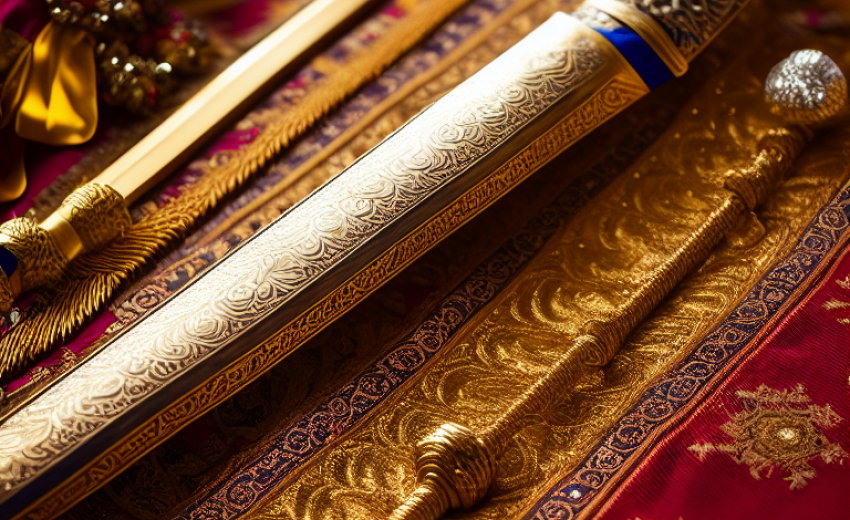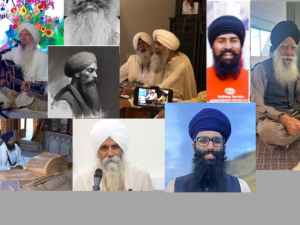The sword of the Khalsa was revealed by Guru Hargobind Sahib. Guru Sahib requested Baba Buddha ji to wear two swords while sitting on the throne of Akal Bunga . Before Guru Arjan Dev ji left for Lahore, Guru ji instructed Hargobind "Sit on his throne and rule according to his ability". Dhadi Abdullah and Nathamal mentioned the two swords of Miri and Piri. Regarding the definition of kirpan, Gurshabad Ratnakar Mahankosh testifies,
"The sword is also called Kirpan, Sri Sahib, Talwar, Shamshir. Kharagdahra is also mentioned in Yajurveda and other Sanskrit texts. There are 32 types of sword wielding" .
Among the Sikhs, the name of Jagat Vinash (assuming Mahankal to be the doer) has also become Kharag, like Namaskar Sri Kharag Ke.
In ancient times the sword was considered an important symbol in Greece, Roman Catholicism, Hinduism and Islam as a weapon of "bravery" and "masculinity". Special mention is made in the history of the swords of Hercules, Khushgani, Shamshir-e-Moman, Elsind, Alexander, Guru Hargobind, Guru Gobind Singh, Rustam, Shamshir-e-Hussain, Tipu Sultan, Hari Singh Nalva etc. When Samarth Ramdas, the religious leader of Shiva ji Marhatha, asked Guru Hargobind,
"I heard that Guru Nanak is sitting on the throne. Guru Nanak was a tyagi saint. You have taken up arms, you have kept an army , and called Sacha Patshah."
Guru Hargobind Sahib replied,
Batan Faqiri, Zahir Amiri,
Sastar Garib ki Rakhya,
Jarwane ki Bhakhya,
Baba Nanak Maya Tyagi Thi
Sansar Nahi Tyagia Tha
Samarth Ramdas immediately after hearing this, said "it appeals to me." The Marhatha chronicle writes that the Mawayar people created good soldiers, comrades and obedient generals for the times to come to fulfill their aspirations. The late Prime Minister of India Lal Bahadur Shastri embraced the concept of Degh Tegh Fateh of the Sikhs that the people of India defined the national slogan as ' Jay Jawan Jay Kisan'.
Although the Hindus of India continued to be enslaved for over two thousand years, the Hindu temples were destroyed and the goods looted by the invaders and the women were sold for Taka Taka in the markets of Ghazni. The history took a revolutionary turn when Guru Nanak Sahib challenged Babar with the sword of contemplation. The martyrdom of Guru Arjan Dev and the martyrdom of Guru Tegh Bahadur Sahib have their own unique place in the annals of the world. Guru Gobind Singh Sahib revealed the Khalsa, placing the sword second in the five kakars. Guru ji wrote King Aurangzeb in Zafarnama :
Choon kar aj hama healte dar guzasht halal ast burdan ba shamshir dast
After the battle of Bhangani, Guru Gobind Singh bestowed on Pir Budhu Shah a 'sword and comb'.
In old Sanskrit texts like Amarkosh etc. it is remembered by the names Kharag, Karwar, Asi, Rishti, Chandrahas etc. Tenth Nanak mentions many weapons in 'Shastar Naam Mala' in which different names of swords are given. Guru Sahib has meditated on the sword and devotion. The prayers of the Sikhs also begin with the Bugatti (sword). In the Bani of Guru Gobind Singh ji, devotion comes only in the name of Kirpan or Akal Purakh. Whenever the Sikhs enjoyed independence, they carried the sword along with their religious freedom. When the sun of the Sikh empire started declining , the British took the initiative to snatch the sword from the Sikhs. Sikhs ignored and maintained the freedom of the sword. The Sikhs had to fight hard for the 'freedom of the sword' at home and abroad . The British government finally allowed the Sikhs to wear a three-foot-long sword by the Lahore Court Judgment in 1924.
In the Nehru Committee 1928 and the Sapru Committee 1945, Sikhs had the full right to carry the sword. The Government of India (Home Deptt, Judicial No: 950, Shimla, June 25, 1914) also allows Sikhs to carry swords. Presently Sikhs are being deliberately harassed. News of Sikh children wearing swords and being harassed in many schools in India and abroad has been appearing in the daily newspapers.





